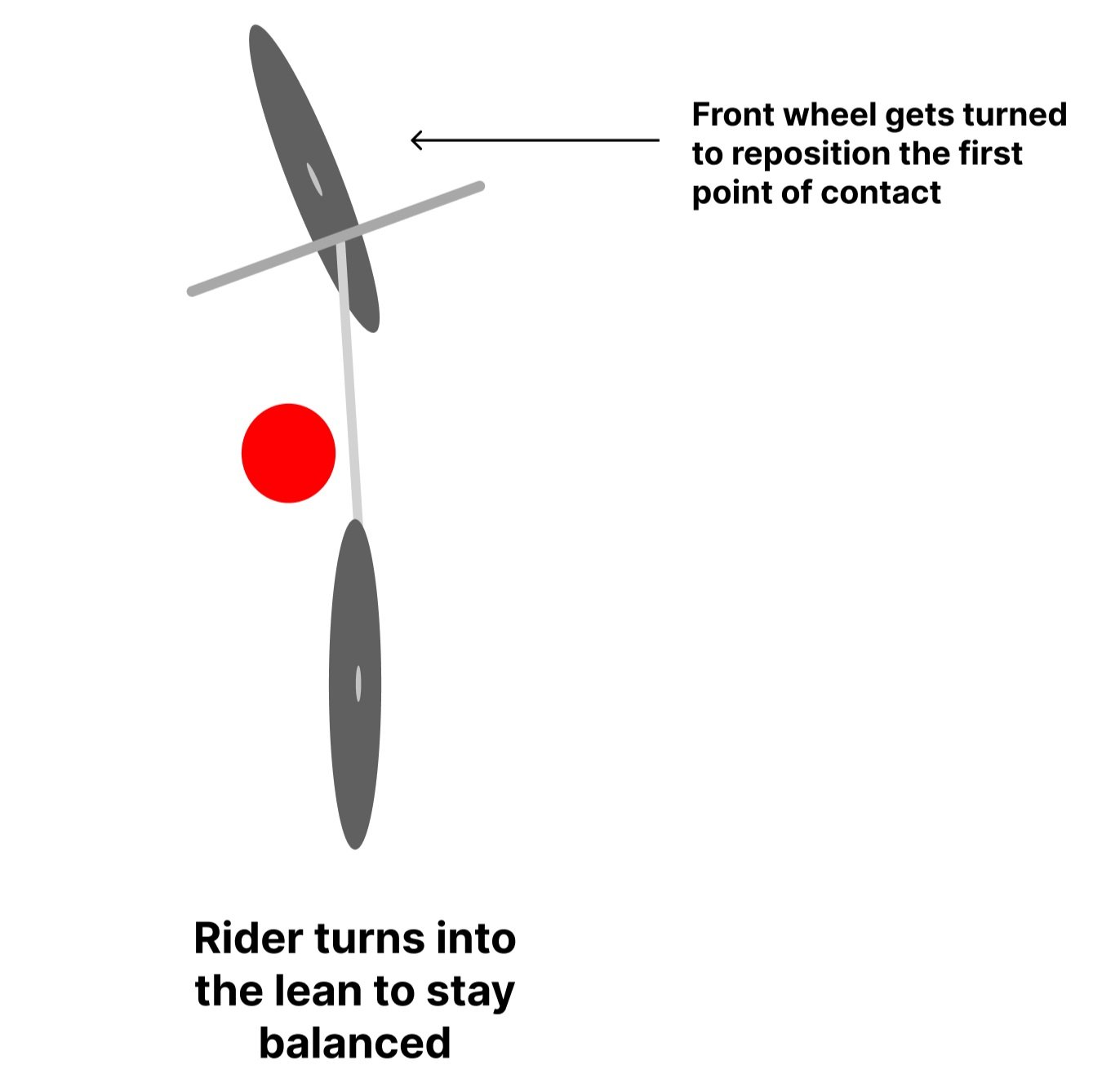Why is it easier to balance a bike in motion?
The short answer
It is easier to balance on a moving bicycle because the momentum enables the bike to be steered into the direction of the lean, which rebalances the bike. The steering design of bikes and, to a minor degree, the gyroscopic precession effect also help a bicycle stay upright while in motion.
The long answer
Bike balance, as it turns out, is a very complicated subject.
Understanding bicycle balance involves exploring several principles of physics, including rotational motion, gyroscopic effects, and the mechanics of steering. In short, there are multiple reasons why it's easier to balance a bike while it’s moving rather than when it’s stationary.
I'll first cover the simplest and most intuitive reason why it's easier to balance on a moving bike and then touch on a few of the other more complicated reasons to round out this answer.
Reason #1: While moving, the rider can steer to correct a fall.
The main reason why it is easier to balance on a moving bike is that steering allows the rider to correct any potential falls.
A bike has two points of contact with the ground — the front wheel and the back wheel — which makes it an inherently unstable object when stationary. To remain balanced on a bicycle, the rider's center of gravity must be aligned over these two contact points.
If the bike starts to tip to one side, the rider's weight is no longer positioned over the two points of contact, and gravity starts to pull them and the bike down. At this point, the rider needs to do something to rebalance the bike.
What must the rider do? Steer! If the bike starts to fall to the left, the rider must turn the front wheel to the left as well. This movement will reposition the front wheel contact point under the rider's weight, which is currently leaning left, allowing the rider to maintain balance.
By turning into the lean, the front wheel realigns under the rider's center of weight, spanning across the two points of contact. Consequently, the back tire adjusts to the right. Steering into the fall, therefore, realigns the two contact points to be under the weight of the rider and allows them to stay balanced.
The ability to steer is crucial for balancing a bike. Why is this so much harder when a bike is still? There's no momentum. If you try to steer a bike while it is completely stopped, the front tire will not move under the center of your weight as the bike has no momentum. The faster the bike moves, the less steering is required, making it easier to maintain balance.
Experienced riders at this point might be saying, "But I'm special! I can balance my bike while waiting at a stoplight like a pro!" Congrats! But you're not balancing while completely still.
Source: "How To Track Stand Like a Pro" by Global Cycling Network
Even when you're doing what's known in the cycling community as a "track stand", you're subtly adding momentum to the bike as you shift your weight on the pedals. These small adjustments allow you to create momentum by moving the bike forwards (and/or backwards if you're on a fixie).
So, the most compelling reason why it’s easier to balance on a moving bike comes down to the ability to steer into the direction of a fall. However, there are additional factors contributing to this stability.
If you give a riderless bike a good push, it will remain upright for about 20 seconds. A static riderless bike, by comparison, will fall over after about 2 seconds. So there's a significant amount of self-stability in bike design that helps it stay upright while moving. Here are some other factors contributing to why it's easier to balance a moving bike:
Reason #2: Steering design includes mechanical trail.
Bicycle steering mechanisms usually feature a specific degree of mechanical trail, which makes it easier to balance a moving bike. The trail is the distance between the point where the front wheel touches the ground and the point where the steering axis intersects the ground. This design element helps keep bikes more stable when in motion.
When a bike leans, this mechanical trail naturally causes the front wheel to turn in the direction of the lean, helping the bike realign under the rider's center of gravity. This self-correcting feature is integral to a bike's stability, especially when it's moving.
Reason #3: Gyroscopic precession helps with stability.
Gyroscopic precession is a physical phenomenon that occurs when a force is applied to a spinning object, like a bicycle wheel. Gyroscopic precession is often credited with being a key factor in why bikes are easier to balance while moving, but this is not entirely true.
When a bicycle wheel spins, it reacts to forces by "precessing," or turning, in a direction perpendicular to where the force is applied. When you lean to the left on a moving bike, gyroscopic precession causes the front wheel to turn slightly left, which aids in balance.
This video includes an excellent demonstration of this gyroscopic precession:
However, the gyroscopic effect alone is not sufficient to keep a bike balanced, as bicycle wheels are not large enough or spinning fast enough to have a major impact. An experiment in the 1970s demonstrated this by adding an extra set of wheels spinning in the opposite direction to cancel out the gyroscopic effect. Even when the gyroscopic effect is neutralized, bikes with a well-designed mechanical trail still remain stable.
In summary, the primary reason why bikes are easier to balance while moving is that riders can steer to correct their balance. The steering design and mechanical trail help with stability, while the gyroscopic precession effect plays a minor role. All these factors together explain why a moving bicycle is easier to balance.
Curious about how the world works?
Today You Should Know is a free, weekly email newsletter designed to help you learn something new every Friday.
Subscribe today 👇
Check out some other curious questions:
Sources
BBC Earth Science. (2013). Why is a bicycle easier to balance at speed? | James May’s Q&A | Head Squeeze. YouTube. Retrieved January 21, 2024, from https://www.youtube.com/watch?v=nhMECbDRVLI
Global Cycling Network. (2013). How To Track Stand Like a Pro. YouTube. Retrieved January 21, 2024, from https://www.youtube.com/watch?v=nRR4paQnUsQ
Jones, D. E. H. (2006, September 1). From the archives: The stability of the bicycle . AIP Publishing. https://pubs.aip.org/physicstoday/article/59/9/51/392993/From-the-archives-The-stability-of-the
MinutePhysics. (2015). How Do Bikes Stay Up? YouTube. Retrieved January 22, 2024, from https://www.youtube.com/watch?v=oZAc5t2lkvo
Nave, C. R. (n.d.). Bicycle wheel. HyperPhysics. http://hyperphysics.phy-astr.gsu.edu/hbase/Mechanics/bicycle.html
TEDx Talks. (2012). Why bicycles do not fall: Arend Schwab at TEDxDelft. YouTube. Retrieved January 22, 2024, from https://www.youtube.com/watch?v=2Y4mbT3ozcA
Why is Balancing a Moving Bicycle Easier?. Science Facts. (2020, December 3). https://www.scifacts.net/physics/why-easier-balance-moving-bicycle/











It’s like an American accent but with calendars.